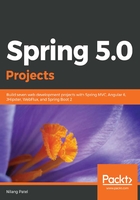
Defining the view templates
We will be using the Thymeleaf template engine for handling server-side templates. Thymeleaf provides various dialects and conditional blocks for rendering the dynamic content within the static HTML. Let's look at some simple syntactical element of Thymeleaf, as follows:
<!-- Dynamic content in HTML tag -->
<div class="alert alert-info">[[${country.name}]]</div>
<!-- Dynamic attributes -->
<span th:class="|alert ${error ? 'alert-danger': _}|">[[${errorMsg}]]</span>
<!-- Looping -->
<ol>
<li th:each="c : ${countries}">
[[${c.name}]]
</li>
</ol>
<!-- Conditionals -->
<div class="alert alert-warning" th:if="${count == 0}">No results found</div>
<!-- Custom attributes -->
<div th:attr="data-count=${count}"></div>
<!-- Form element value -->
<input type="text" th:value="${country.name}" name="name" />
From the previous examples, we can observe that the items to be evaluated by Thymeleaf are prefixed with th: and any content to be rendered between the tags can be done either using th:text or [[${variable}]]. The latter syntax has been introduced in Thymeleaf 3. This was a very short primer, as going in to depth on Thymeleaf is out of the scope of this book. A beautiful guide explaining different parts of the template can be found at http://www.thymeleaf.org/doc/tutorials/3.0/usingthymeleaf.html.